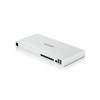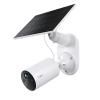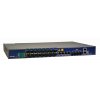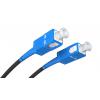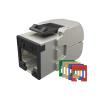-
zł
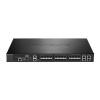
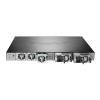
Il D-Link DXS-3400-24SC è uno switch gestito con 20 slot SFP+ (10 Gb/s) e 4 porte 10G Combo (è possibile scegliere tra 10G Ethernet o SFP+). Il dispositivo si distingue per l'elevata efficienza: il throughput è di 480 Gb / s e la velocità di inoltro dei pacchetti è di 357,12 Mp / s. Perfetto come switch principale in molte reti, è stato progettato per l'utilizzo in Data Center. Ha una serie di funzioni DCB (Data Center Bridging) che garantiscono la piena larghezza di banda Ethernet: 802.1Qbb, 802.1Qaz e 802.1Qau. È dotato di un adattatore CA integrato, il consumo energetico massimo è di 118,6 W.
Il dispositivo supporta funzioni di gestione avanzate di Layer 2 e Layer 3. Nel layer 2 supporta, tra gli altri, i protocolli Flow Control, Spanning Tree, 802.1AX Link Aggregation, VLAN/flow/port mirroring e tunneling del protocollo L2. Supporta anche L2 Multicast - Snooping MLD, Snooping IGMP e Snooping PIM. Nel livello 3, supporta il routing, incluso il routing statico, il routing hardware, BFD o RIP. Consente una configurazione VLAN avanzata, supporta 802.1Q, 802.1v, Q-in-Q, VLAN vocale, VLAN di sorveglianza automatica, trunking VLAN e molte altre funzioni. Lo switch è predisposto anche per lo stacking, in uno stack fisico è possibile connettere fino a 4 dispositivi con una banda passante di 80 Gb/s, in topologia ad anello oa catena. La gestione avviene tramite interfaccia utente Web in un browser, Telnet o D-Link.
Il set include 1 modulo di alimentazione!
Le caratteristiche più importanti:
- 20 SFP + slot (10 Gb/s);;
- 4 porte 10G Combo (Ethernet 10G o SFP+);
- prestazioni di commutazione: 480 Gb/s;
- velocità di inoltro dei pacchetti: 357,12 Mp/s;;
- impilare fino a 4 dispositivi in uno stack fisico;;
- Gestione del livello 3.
Specifica:
| DXS-3400-24SC | |
| Proprietà generali | |
|---|---|
| Interfacce |
20 slot SFP+ 10 Gb/s
4 porte 10G Combo - 10G Ethernet lub SFP+ 10 Gb/s |
| Porta console | RJ-45 i miniUSB |
|
Porta di gestione |
10/100/1000BASE-T RJ-45 Ethernet |
| Porte USB | 1 |
| Prestazione | |
| Capacità di commutazione | 480 Gb/s |
| Velocità di inoltro dei pacchetti | 357,12 Mp/s |
| Buffer di pacchetti | 4 MB |
| Tabella degli indirizzi MAC | 48K |
| Proprietà fisiche | |
| Ingresso alimentazione | 100 - 240 V AC |
| Consumo energetico massimo | 118,6 W |
| Pobór mocy w trybie standby | 64,8 W |
| Rilascio di calore | 388.39 BTU/hr |
| Dimensioni | 441 x 44 x 380 mm (17.32 x 1.73 x 14.96 inches) |
| Peso | 6,5 kg |
| Temperatura di esercizio consentita | Da -5 a 50 st. C |
| Temperatura di stoccaggio consentita | Da -40 a 70 st. C |
| Umidità dell'aria consentita | 0%-95% RH senza condensa |
|
Umidità dell'aria consentita durante lo stoccaggio |
0%-95% RH senza condensa |
| Certificati | |
| Sicurezza | cUL, CB, CE, CCC, BSMI |
| EMI / EMC | CE, FCC, C-Tick, VCCI, BSMI, CCC |
| Proprietà del software | |
| Stack |
Fisico stack
Virtualee stack
|
| Funzioni del livello 2 | MAC Address Table
Port mirroring
L2 protocol tunneling Loopback Detection (LBD) iSCSI awareness Multi-Chassis Link Aggregation (MLAG) |
| Funzioni Layer 2 Multicast | MLD Snooping
|
| Funzioni Layer 3 | ARP
IPv6 Neighbor Discovery (ND) UDP helper IPv6 tunneling
VRRP v2/v3 |
| Layer 3 routing | Static routing
Policy-based Route (PBR) Null route Bidirectional Forwarding Detection (BFD)
RIP
Route Redistribution
|
| VLAN | 802.1Q 802.1v Double VLAN (Q-in-Q)
Port-based VLAN MAC-based VLAN Subnet-based VLAN Private VLAN VLAN group
Voice VLAN Auto Surveilliance VLAN VLAN trunking GVRP
|
| AAA | 802.1X authentication
Web-based Access Control (WAC)
Microsoft NAP
Authentication Database Failover Guest VLAN |
| Quality of Service (QoS) | 802.1p Quality of Service 8 queues per port QoS based on
|
| Data Center Bridging (DSB) | 802.1Qbb Priority-based Flow Control (PFC) 802.1Qaz Enhanced Transmission Selection (ETS) 802.1Qau Congestion Notification (CN) |
| Controllo di accesso (ACL) | ACL based on:
|
| Sicurezza | Port Security
D-Link Safeguard Engine DHCP server screening IP-MAC-Port Binding Dynamic ARP Inspection IP Source Guard DHCP Snooping IPv6 Snooping DHCPv6 Guard IPv6 Route Advertisement (RA) Guard IPv6 ND Inspection ARP Spoofing Prevention
L3 Control Packet Filtering Traffic Segmentation SSL
DoS attack prevention |
| OAM | Cable diagnostics 802.3ah Ethernet link OAM D-Link Unidirectional Link Detection (DULD) Dying Gasp 802.1ag Connectivity Fault Management (CFM) Y.1731 OAM Optical Transceiver Digital Diagnostic Monitoring (DDM) |
| Gestione | Web-based GUI CLI Telnet server Telnet client TFTP client FTP client Secure FTP (SFTP) server Traffic monitoring SNMP
System log DHCP client DHCP server DHCP Relay options 60, 61, 82 Multiple images Multiple configurations Flash file system DNS client CPU monitoring MTU setting ICMP tools
DNS Relay SMTP DHCP Auto Configuration NTP RCP (Remote Copy Protocol) RMON v1/v2 Trusted host Password encryption Debug command sFlow Switch Resource Management (SRM) Microsoft Network Load Balancing (NLB) |
| Standard | |
| MIB i RFC | MIB Structure: RFC1065, RFC1066, RFC1155, RFC1156, RFC2578 Concise MIB Definitions: RFC1212 MIBII: RFC1213 MIB Traps Convention: RFC1215 Bridge MIB: RFC1493, RFC4188 SNMP MIB: RFC1157, RFC2571, RFC2572, RFC2573, RFC2574, RFC2575, RFC2576 SNMPv2 MIB: RFC1442, RFC1901, RFC1902, RFC1903, RFC1904, RFC1905, RFC1906, RFC1907, RFC1908, RFC2578, RFC3418, RFC3636 RMON MIB: RFC271, RFC1757, RFC2819 RMONv2 MIB: RFC2021 Ether-like MIB: RFC1398, RFC1643, RFC1650, RFC2358, RFC2665, RFC3635 802.3 MAU MIB: RFC2668 802.1p MIB: RFC2674, RFC4363 Interface Group MIB: RFC2863 RADIUS Authentication Client MIB: RFC2618 MIB for TCP: RFC4022 MIB for UDP: RFC4113 MIB for Diffserv.: RFC3298 RADIUS Accounting Client MIB: RFC2620 Ping & TRACEROUTE MIB: RFC2925 Running configuration writes and backup (D-Link MIB) TFTP uploads and downloads (D-Link MIB) Trap MIB (D-Link MIB) IPv6 MIB: RFC2465 ICMPv6 MIB: RFC2466 Entity MIB: RFC2737 VRRP MIB: RFC2787 RIPv2 MIB: RFC1724 OSPF MIB: RFC1850 IPv4 Multicast Routing MIB: RFC5132, RFC2932 PIM MIB for IPv4: RFC2934 IP Forwarding Table MIB: RFC4292 IPv6 SNMP Mgmt Interface MIB: RFC4293 DDM MIB (D-Link MIB) Private MIB (D-Link MIB) DIFFSERV MIB (D-Link MIB) MIB for D-Link Zone Defense (D-Link MIB) IP: RFC791 UDP: RFC768 TCP: RFC793 ICMPv4: RFC792 ICMPv6: RFC2463, RFC4443 Extended ICMP to Support Multi-Part Messages: RFC4884 ARP: RFC826 CIDR: RFC1338, RFC1519 Definition of the DS Field in the IPv4 and IPv6 Headers: RFC2474, RFC3168, RFC3260 Extensible Authentication Protocol (EAP): RFC1321, RFC2284, RFC2865, RFC2716, RFC1759, RFC3580, RFC3748 SNMP Framework: RFC2571 SNMP Message Processing and Dispatching: RFC2572 SNMP Applications: RFC2573 User-based Security Model for SNMPv3: RFC2574 Expedited Forwarding PHB (Per-Hop Behavior): RFC3246 Supplemental Information for the New Definition of the EF PHB (Expedited Forwarding Per-Hop Behavior): RFC3247 DNS extension support for IPv6: RFC1886 Path MTU Discovery for IPv6: RFC1981 IPv6: RFC2460 Neighbor Discovery for IPv6: RFC2461, RFC4861 IPv6 Stateless Address Auto-configuration: RFC2462, RFC4862 IPv6 over Ethernet and definition: RFC2464 Dual Stack Hosts using the “Bump-In-the-Stack” Technology: RFC2767 IPv6 Addressing Architecture: RFC3513, RFC4291 IPv4/IPv6 dual stack function: RFC2893, RFC4213 Default Address Selection for Internet Protocol version 6: RFC3484 IP-IP tunnel: IP Encapsulation within IP: RFC2003 IP-IP tunnel:Allow MTU = 1500 or 1520: RFC1191 L2 distributed tunnel - CAPWAP Encapsulation: RFC5415 |






 Polski
Polski English
English Italiano
Italiano Español
Español Čeština
Čeština Српски
Српски Deutsch
Deutsch Ελληνικά
Ελληνικά Slovenský
Slovenský

